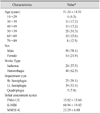Abstract
Objective
We conducted a retrospective data analysis to review the results of robot-assisted arm rehabilitation in post stroke patients during past 2 years and find out positive influences of the outcomes.
Method
We measured improvements of arm function longitudinally in a group of sixty-four stroke patients, who participated in the robot-assisted arm therapy from January 2012 to December 2013. Treatment session lasted 30 to 40 minutes, 2 to 5 times a week. For at least more than one month, we used the InMotion2.0 (Interactive Motion Technologies, Watertown, MA, USA) and measured outcomes with the Fugl-Meyer assessment-upper extremity (FMA-UE), Korea-modified Barthel index (K-MBI) and InMotion robot arm evaluation index. Also, analysis on the subgroup was carried out.
Results
Following the robot-assisted arm rehabilitation, FMA-UE, K-MBI and InMotion robot arm evaluation index were significantly improved compared to baseline. Mean FMA-UE and K-MBI gain were 4.22 ± 0.76, 7.63 ± 1.18 in each. However, in the subgroup analysis, the group with less intensity treatment (640 repetition) did not show any significant improvement.
Figures and Tables
Table 2
Duration, Frequency-adjusted Means of Overall Clinical Outcome Variables between Pre- and Post-treatment of Robot-assisted Arm Rehabilitation

Table 3
Comparison of Clinical Outcomes of FMA-UE Subgroups between Pre- and Post-treatment of Robot-assisted Arm Rehabilitation

Table 4
Comparison of Clinical Outcomes of K-MBI Subgroups between Pre- and Post-treatment of Robot-assisted Arm Rehabilitation

References
1. Go AS, Mozaffarian D, Roger VL, Benjamin EJ, Berry JD, Blaha MJ, Dai S, Ford ES, Fox CS, Franco S. Heart Disease and Stroke Statistics-2014 Update A Report From the American Heart Association. Circulation. 2014; 129:e28–e292.
2. Shin MJ, Kim SH, Lee CH, Shin YI. Optimal strategies of upper limb motor rehabilitation after stroke. Brain Neurorehabil. 2014; 7:21–29.
3. Rabadi M, Galgano M, Lynch D, Akerman M, Lesser M, Volpe B. A pilot study of activity-based therapy in the arm motor recovery post stroke: a randomized controlled trial. Clin Rehabil. 2008; 22:1071–1082.
4. Langhorne P, Bernhardt J, Kwakkel G. Stroke rehabilitation. Lancet. 2011; 377:1693–1702.
5. Pekna M, Pekny M, Nilsson M. Modulation of neural plasticity as a basis for stroke rehabilitation. Stroke. 2012; 43:2819–2828.
6. Wieloch T, Nikolich K. Mechanisms of neural plasticity following brain injury. Curr Opin Neurobiol. 2006; 16:258–264.
7. Zemke AC, Heagerty PJ, Lee C, Cramer SC. Motor cortex organization after stroke is related to side of stroke and level of recovery. Stroke. 2003; 34:e23–e26.
8. Chang WH, Kim YH. Robot-assisted Therapy in Stroke Rehabilitation. J Stroke. 2013; 15:174–181.
9. Lo AC, Guarino PD, Richards LG, Haselkorn JK, Wittenberg GF, Federman DG, Ringer RJ, Wagner TH, Krebs HI, Volpe BT, Bever CT Jr, Bravata DM, Duncan PW, Corn BH, Maffucci AD, Nadeau SE, Conroy SS, Powell JM, Huang GD, Peduzzi P. Robot-assisted therapy for long-term upper-limb impairment after stroke. N Engl J Med. 2010; 362:1772–1178.
10. Kwakkel G, Kollen BJ, Krebs HI. Effects of robot-assisted therapy on upper limb recovery after stroke: a systematic review. Neurorehabil Neural Repair. 2008; 22:111–121.
11. Gladstone DJ, Danells CJ, Black SE. The Fugl-Meyer assessment of motor recovery after stroke: a critical review of its measurement properties. Neurorehabil Neural Repair. 2002; 16:232–240.
12. Platz T, Pinkowski C, van Wijck F, Kim IH, di Bella P, Johnson G. Reliability and validity of arm function assessment with standardized guidelines for the Fugl-Meyer Test, Action Research Arm Test and Box and Block Test: a multicentre study. Clin Rehabil. 2005; 19:404–411.
13. Krebs HI, Krams M, Agrafiotis DK, DiBernardo A, Chavez JC, Littman GS, Yang E, Byttebier G, Dipietro L, Rykman A, McArthur K, Hajjar K, Lees KR, Volpe BT. Robotic measurement of arm movements after stroke establishes biomarkers of motor recovery. Stroke. 2014; 45:200–204.
14. See J, Dodakian L, Chou C, Chan V, McKenzie A, Reinkensmeyer DJ, Cramer SC. A standardized approach to the Fugl-Meyer assessment and its implications for clinical trials. Neurorehabil Neural Repair. 2013; 27:732–741.
15. Jung HY, Park BK, Shin HS, Kang YK, Pyun SB, Paik NJ, Kim SH, Kim TH, Han TR. Development of the Korean version of Modified Barthel Index (K-MBI): multi-center study for subjects with stroke. J Korean Acad Rehabil Med. 2007; 31:283–297.
16. Kwon YC, Park JH. Korean version of Mini-Mental State Examination (MMSE-K). Part I: development of the test for the elderly. J Korean Neuropsychiatr Assoc. 1989; 28:125–135.
17. Park J, Kwon Y. Standardization of Korean version of the Mini-Mental State Examination (MMSE-K) for use in the elderly: Part II. diagnostic validity. J Korean Neuropsychiatr Assoc. 1989; 28:508–513.
18. Hsieh Yw, Lin Kc, Wu Cy, Lien Hy, Chen Jl, Chen Cc, Chang Wh. Predicting Clinically Significant Changes in Motor and Functional Outcomes After Robot-Assisted Stroke Rehabilitation. Arch Phys Med Rehabil. 2013.
19. Volpe BT, Krebs HI, Hogan N, Edelsteinn L, Diels CM, Aisen ML. Robot training enhanced motor outcome in patients with stroke maintained over 3 years. Neurology. 1999; 53:1874–1876.
20. Norouzi-Gheidari N, Archambault PS, Fung J. Effects of robot-assisted therapy on stroke rehabilitation in upper limbs: systematic review and meta-analysis of the literature. J Rehabil Res Dev. 2012; 49:479–496.
21. Hsieh YW, Wu CY, Liao WW, Lin KC, Wu KY, Lee CY. Effects of treatment intensity in upper limb robot-assisted therapy for chronic stroke: a pilot randomized controlled trial. Neurorehabil Neural Repair. 2011; 25:503–511.
22. Hsieh YW, Wu CY, Lin KC, Yao G, Wu KY, Chang YJ. Dose-response relationship of robot-assisted stroke motor rehabilitation: the impact of initial motor status. Stroke. 2012; 43:2729–2734.




 PDF
PDF ePub
ePub Citation
Citation Print
Print






 XML Download
XML Download